ASUS X99-A Motherboard Review
by Ian Cutress on December 22, 2014 2:00 PM EST- Posted in
- Motherboards
- Intel
- Asus
- Haswell-E
- LGA2011-3
CPU Performance
Readers of our motherboard review section will have noted the trend in modern motherboards to implement a form of MultiCore Enhancement / Acceleration / Turbo (read our report here) on their motherboards. This does several things, including better benchmark results at stock settings (not entirely needed if overclocking is an end-user goal) at the expense of heat and temperature. It also gives in essence an automatic overclock which may be against what the user wants. Our testing methodology is ‘out-of-the-box’, with the latest public BIOS installed and XMP enabled, and thus subject to the whims of this feature. It is ultimately up to the motherboard manufacturer to take this risk – and manufacturers taking risks in the setup is something they do on every product (think C-state settings, USB priority, DPC Latency / monitoring priority, memory subtimings at JEDEC). Processor speed change is part of that risk, and ultimately if no overclocking is planned, some motherboards will affect how fast that shiny new processor goes and can be an important factor in the system build.
For reference, the ASUS X99-A does not implement Multi-Core Turbo.
Point Calculations – 3D Movement Algorithm Test: link
3DPM is a self-penned benchmark, taking basic 3D movement algorithms used in Brownian Motion simulations and testing them for speed. High floating point performance, MHz and IPC wins in the single thread version, whereas the multithread version has to handle the threads and loves more cores.
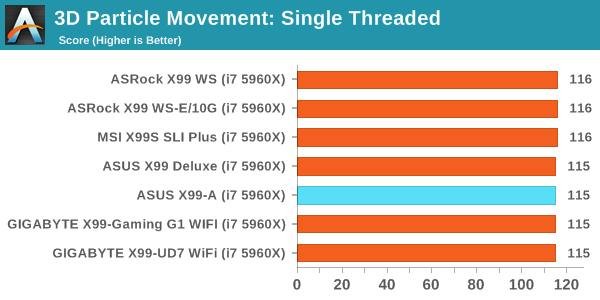

Compression – WinRAR 5.0.1: link
Our WinRAR test from 2013 is updated to the latest version of WinRAR at the start of 2014. We compress a set of 2867 files across 320 folders totaling 1.52 GB in size – 95% of these files are small typical website files, and the rest (90% of the size) are small 30 second 720p videos.
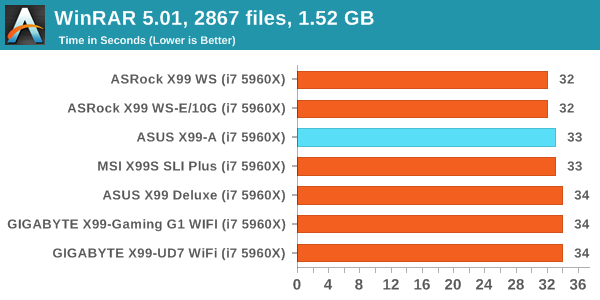
Image Manipulation – FastStone Image Viewer 4.9: link
Similarly to WinRAR, the FastStone test us updated for 2014 to the latest version. FastStone is the program I use to perform quick or bulk actions on images, such as resizing, adjusting for color and cropping. In our test we take a series of 170 images in various sizes and formats and convert them all into 640x480 .gif files, maintaining the aspect ratio. FastStone does not use multithreading for this test, and thus single threaded performance is often the winner.
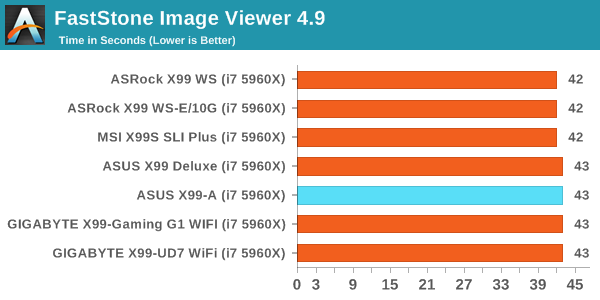
Video Conversion – Handbrake v0.9.9: link
Handbrake is a media conversion tool that was initially designed to help DVD ISOs and Video CDs into more common video formats. The principle today is still the same, primarily as an output for H.264 + AAC/MP3 audio within an MKV container. In our test we use the same videos as in the Xilisoft test, and results are given in frames per second.

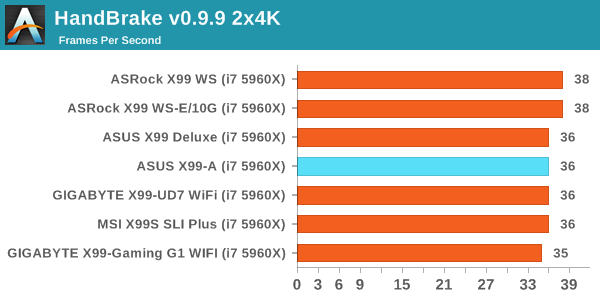
Rendering – PovRay 3.7: link
The Persistence of Vision RayTracer, or PovRay, is a freeware package for as the name suggests, ray tracing. It is a pure renderer, rather than modeling software, but the latest beta version contains a handy benchmark for stressing all processing threads on a platform. We have been using this test in motherboard reviews to test memory stability at various CPU speeds to good effect – if it passes the test, the IMC in the CPU is stable for a given CPU speed. As a CPU test, it runs for approximately 2-3 minutes on high end platforms.
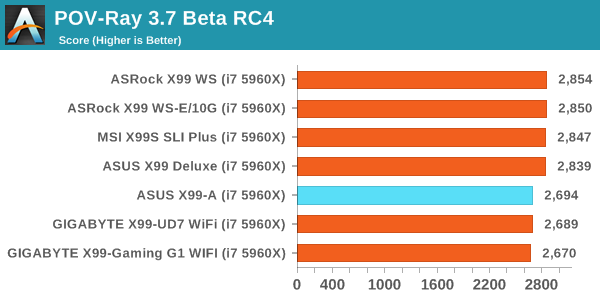
Synthetic – 7-Zip 9.2: link
As an open source compression tool, 7-Zip is a popular tool for making sets of files easier to handle and transfer. The software offers up its own benchmark, to which we report the result.











37 Comments
View All Comments
DanNeely - Tuesday, December 23, 2014 - link
No. Look at the pictures; 6 blue (3.0) and 4 black (2.0) USB ports.Until Intel goes all USB3 on it chipset, most boards with many ports are either going to do a mix of both types, fake it with hub chips, or both. And since the Skylake Leaks indicate we'll probably still be mixed USB (or hub) on higher end boards (midrange will probably be able to go all 3.0); it's probably going to be 2017 until USB3.x becomes ubiquitous.
kenshinco - Tuesday, December 23, 2014 - link
You said this board doesn't implement Multicore Turbo but its specs does says Intel Turbo boost supported. Could you elaborate more on this.Does this means it will get turbo boosted for single core only? 8 cores active can not get turbo boosted?
SuperVeloce - Wednesday, December 24, 2014 - link
This most likely means turbo boost is behaving as Intel said it should, more cores active, lower the frequency (for 5960x and all cores its usually 3-3.2ghz). Multicore turbo usually gets you highest turbo frequency for all cores (so it would leave it 3.5ghz@16threads if temperatures allow it).dcoca - Friday, January 9, 2015 - link
I have this board and Multicore is there in the bios with the opt for all cores or per core...EricCC - Wednesday, December 24, 2014 - link
Great article. I was ready to buy one until I saw the post times. 20+ seconds is horrible. My two year old Surface and one year laptop with Haswell post in 2-3 seconds and their CPUs are much slower. And my 5+ year old system is twice as fast posting.I thought EFI BIOS were supposed to be significantly faster and I expected newer machines to be faster. Have manufacturers explained the severe slowness?
Are these new motherboards any faster with Windows 8?
EricCC - Wednesday, December 24, 2014 - link
i should have said, any faster POSTING with Windows 8?DanNeely - Wednesday, December 24, 2014 - link
POST is the time spend *before* the boot loader starts your OS. In general, the more stuff that needs to be started up, the longer it will take to POST; however, I suspect that an additional factor vs Z97 boards which post in half the time is that more effort has been put into optimizing performance for the mass market product than for something that's mostly used in servers/etc where it's a much less important factor.EricCC - Thursday, December 25, 2014 - link
I am aware that POST time is pre-OS, and all the times I stated are POST only. The OS loads in around 10 seconds so most of my systems boot faster than the X99 motherboards POST. Do you think these boards would POST faster with Windows 8? I thought systems that were Windows 8 aware were able to skip part of POST or at least do something differently.I also agree that POST and boot times in servers tends not to be that important but I don't think these boards are for servers, which don't need the ability to run with multiple graphics cards or to overclock.
Do you not think that 20+ second POST times are extremely long for computers nowadays?
DanNeely - Thursday, December 25, 2014 - link
No. Your OS has nothing, and can have nothing, to do with POST time because your OS doesn't get involved until the POST is complete. It doesn't matter if you're running Windows 8. or Windows 7, or Windows 3.11, or Linux, or BSD, or BeOS.What Win8 does is to only partially shutdown by default when you turn it off. It closes down everything in userspace and then hibernates the kernel. Then when you power on, after the computer POSTs, and after the boot loader starts win8, win8 just unhibernates the kernel and restarts userland; which is faster than starting the OS from scratch. This also only helps if you're someone who turns his computer off on a regular basis instead of just leaving it up until the next patch tuesday; because in that case the patches require restarting the kernel.
These boards aren't going into servers; but 99% of consumer boards are LGA1150; which is where the OEMs put their effort. LGA2011 is an entry level server product; and 99% of the chipsets for them go into servers where it doesn't matter.
X99 is too small a market to justify any sort of performance tuning; the boards are already a lot more expensive than z97 because the tiny number of boards that are sold means there's not much to spread the engineering costs for the board layout over. If you wanted to lift the base price of the boards another $100+ each it might be possible to optimize the startup times down to the same 10s ballpark of z97. You'll probably never see desktop boards get down to the 1-3s range of thin laptops/tablets because the latter have so much less stuff to enable, and everything that they need to turn on and since everything is soldiered and non-replacable they can encode all the settings into the firmware instead of having to detect the components and determine how to configure them every time they're powered on.
ziphnor - Friday, December 26, 2014 - link
The X99-A BIOS is full of options that allow faster POST (like not looking for other drives than the boot drive etc). So it can probably be tweaked.